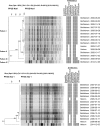Evaluation of Shigella Species Azithromycin CLSI Epidemiological Cutoff Values and Macrolide Resistance Genes
- PMID: 30700507
- PMCID: PMC6440796
- DOI: 10.1128/JCM.01422-18
Evaluation of Shigella Species Azithromycin CLSI Epidemiological Cutoff Values and Macrolide Resistance Genes
Abstract
Azithromycin (AZM) has been recommended by the American Academy of Pediatrics for the treatment of shigellosis in children. In this study, 502 Shigella species isolated between 2004 and 2014 were tested for AZM epidemiological cutoff values (ECV) by disk diffusion. AZM MICs and the presence of the macrolide resistance genes [erm(A), erm(B), erm(C), ere(A), ere(B), mph(A), mph(B), mph(D), mef(A), and msr(A)] were determined for all 56 (11.1%) isolates with an AZM disk diffusion zone diameter of ≤15 mm. The distribution of AZM ECV MICs was also determined for 186 Shigella isolates with a disk zone diameter of ≥16 mm. Finally, pulsed-field gel electrophoresis (PFGE) was performed on 15 Shigella flexneri isolates with an AZM disk zone diameter of <16 mm from different years and geographic locations. Serotyping the 502 Shigella species isolates revealed that 373 (74%) were S. sonnei, 119 (24%) were S. flexneri, and 10 (2%) were S. boydii Of the 119 Shigella flexneri isolates, 48 (42%) isolates had an AZM disk diffusion zone diameter of ≤15 mm and a MIC of ≥16 µg/ml. With the exception of one isolate, all were positive for the macrolide resistance gene mph(A). S. flexneri PFGE showed four distinct patterns, with patterns I and II presenting with 92.3% genetic similarity. On the other hand, 2 (0.5%) of the 373 S. sonnei isolates had the AZM non-wild-type (NWT) ECV phenotype (those with acquired or mutational resistance), as the AZM MICs were ≥32 µg/ml and the isolates were positive for the mph(A) gene. Overall, our S. flexneri results are in concordance with the CLSI AZM ECV, but isolates with an AZM disk diffusion zone diameter between 14 and 15 mm should be carefully evaluated, as the S. flexneri AZM MIC for NWT isolates may need adjustment to 32 µg/ml. Our data on S. sonnei support that the AZM NWT ECV should be 11 mm for the disk diffusion zone diameter and ≥32 µg/ml for the MICs.
Keywords: Shigella; azithromycin; epidemiological cutoff values.
Copyright © 2019 American Society for Microbiology.
Figures


Similar articles
-
Multiple Mechanisms Confer Resistance to Azithromycin in Shigella in Bangladesh: a Comprehensive Whole Genome-Based Approach.Microbiol Spectr. 2022 Aug 31;10(4):e0074122. doi: 10.1128/spectrum.00741-22. Epub 2022 Jul 25. Microbiol Spectr. 2022. PMID: 35876510 Free PMC article.
-
Multidrug-resistant conjugative plasmid carrying mphA confers increased antimicrobial resistance in Shigella.Sci Rep. 2024 Mar 23;14(1):6947. doi: 10.1038/s41598-024-57423-1. Sci Rep. 2024. PMID: 38521802 Free PMC article.
-
[Investigation of Azithromycin Minimum Inhibitory Concentration Values and Carbapenem Resistance in Salmonella and Shigella Clinical Isolates].Mikrobiyol Bul. 2021 Oct;55(4):480-491. doi: 10.5578/mb.20219702. Mikrobiyol Bul. 2021. PMID: 34666650 Turkish.
-
Prevalence of Shigella species and antimicrobial resistance patterns in Africa: systematic review and meta-analysis.BMC Infect Dis. 2024 Oct 29;24(1):1217. doi: 10.1186/s12879-024-09945-2. BMC Infect Dis. 2024. PMID: 39472797 Free PMC article.
-
Mechanism of action, resistance, synergism, and clinical implications of azithromycin.J Clin Lab Anal. 2022 Jun;36(6):e24427. doi: 10.1002/jcla.24427. Epub 2022 Apr 21. J Clin Lab Anal. 2022. PMID: 35447019 Free PMC article. Review.
Cited by
-
The increasing antimicrobial resistance of Shigella species among Iranian pediatrics: a systematic review and meta-analysis.Pathog Glob Health. 2023 Oct;117(7):611-622. doi: 10.1080/20477724.2023.2179451. Epub 2023 Feb 16. Pathog Glob Health. 2023. PMID: 36794800 Free PMC article.
-
Shigella flexneri Outbreak at a Rehabilitation Center: First Report from Saudi Arabia.Healthcare (Basel). 2025 Apr 23;13(9):971. doi: 10.3390/healthcare13090971. Healthcare (Basel). 2025. PMID: 40361750 Free PMC article.
-
Characterization of Shigella flexneri Serotype 6 Strains Isolated from Bangladesh and Identification of a New Phylogenetic Cluster.J Bacteriol. 2023 Apr 25;205(4):e0040622. doi: 10.1128/jb.00406-22. Epub 2023 Mar 16. J Bacteriol. 2023. PMID: 36927058 Free PMC article.
-
Molecular characterization of IncFII plasmid carrying blaNDM-5 in a Salmonella enterica serovar Typhimurium ST34 clinical isolate in China.mSphere. 2023 Dec 20;8(6):e0048023. doi: 10.1128/msphere.00480-23. Epub 2023 Nov 1. mSphere. 2023. PMID: 37909767 Free PMC article.
-
Antibiotic resistance and molecular characterization of clinical Shigella spp. isolated from hospitals located in Tehran and Qazvin cities, Iran.BMC Res Notes. 2025 Mar 11;18(1):110. doi: 10.1186/s13104-025-07113-6. BMC Res Notes. 2025. PMID: 40069812 Free PMC article.
References
-
- Jain SK, Gupta A, Glanz B, Dick J, Siberry GK. 2005. Antimicrobial-resistant Shigella sonnei: limited antimicrobial treatment options for children and challenges of interpreting in vitro azithromycin susceptibility. Pediatr Infect Dis J 24:494–497. doi:10.1097/01.inf.0000164707.13624.a7. - DOI - PubMed
-
- Morales Espinosa RM, González-Valencia G, Muñoz O, Torres J. 1993. Production of cytotoxins and enterotoxins by strains of Shigella and Salmonella isolated from children with bloody diarrhea. Arch Med Res 24:13–21. - PubMed
-
- Heiman KE, Karlsson M, Grass J, Howie B, Kirkcaldy RD, Mahon B, Brooks JT, Bowen A, Centers for Disease Control and Prevention. 2014. Notes from the field: Shigella with decreased susceptibility to azithromycin among men who have sex with men–United States, 2002-2013. MMWR Morb Mortal Wkly Rep 63:132–133. - PMC - PubMed
MeSH terms
Substances
LinkOut - more resources
Full Text Sources
Medical

